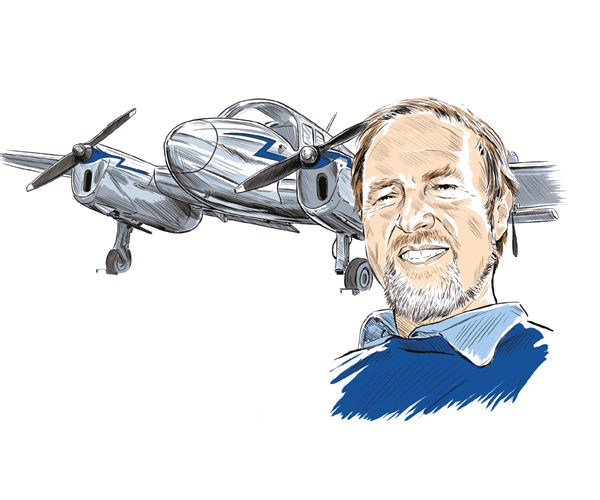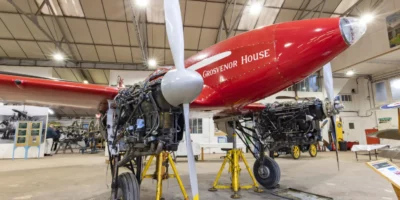Isolation and its many implications is clearly something we must get used to, and nobody anywhere can now be unaware of the need. Before the reality though, I’d have found it hard to predict any benefit to personal aviation. No driving to the airfield, no maintenance, no flying… A tiny burden when compared with some, but a burden nonetheless. Or maybe not… For the last seven weeks, almost every day I have walked the 10 yards to my workshop where I have spent the following eight hours. Better still, I have been there guilt-free, having my intellect tested by a constant diet of Radio 4.
“Deep in France, I found a 1.6 litre all-aluminium Citroën diesel engine with belt-driven reduction, destined for a Jodel D11”
A while back, I designed and built an automotive engine conversion based on a 2.0 litre VW turbo diesel. It ran on the test bed sufficiently well, and for long enough that I would have been happy to sit behind it there and then. Sadly that proved almost to be the easier part. Finding something uncertified which needed the power and could carry the weight, turned out to be more difficult. I should have seen that before I started, but the zeal which is essential to any project tends to narrow the focus. The engine and reduction drive is still in storage, and still largely complete. If my numbers ever come up, it will emerge, blinking into the sunlight, and be installed in a Jodel D140, assuming I can find one.
Meanwhile, in its place in my current ‘second home’ is what I might have done in the first place, which is to build a smaller, simpler and lighter 110hp version. There was some rationale – there were a number of options already in that segment, and any bonus in fuel saving in return for a lot of labour and expense is less. You can always work out what that saving might be, and then divide into the latter and reveal a much smaller fraction than you hoped – but, and as I intend to discover – fuel saving is not the only bonus.
The Mk1 experience did at least make me think a bit more beforehand about the Mk2. The current intense focus on electric/hybrid aviation had yet to gain real momentum when I started, so an emerging consideration was to go down that route. I didn’t, partly because I know a little bit about piston engines but not much about electric motors and their drivetrains, but more because the aircraft really needs to be designed for them in the first place. The electric motor is much lighter than a reciprocating engine, and then you need somewhere to put the batteries, manage the cooling, design the electronic control and so on.
It’s not insurmountable – Tecnam is working on a plug-in Rotax 915-based engine and battery power egg – but something similar is outside my means or skills. Like an electric car (which I would also like, but are not yet a feature in Bangernomics) what I need is something that works now, and that I can just about afford.
Languishing in a workshop deep in France, I found a 1.6 litre all-aluminium diesel engine from a Citroën C3, complete with the basis of a belt-driven reduction, destined apparently for a putative Jodel D11. Part of a negotiating tactic was to point out that a D11 had been designed for a VW engine, which was already lighter than a Rotax. A track coaching experience at Hautes-Saintonge, near La Rochelle, then provided an excuse to visit, during which the engine was finally exchanged for cash and loaded first into a hire car, then the transporter bringing the exotics back to Blighty. I then realised that this was the engine which Ian and I had flown to France in the Seager Air 182, in order to see it running. Negotiations had foundered on the question of purchase price, after which I resolved to do my own. Hard to believe that was back in 2011, which only makes stark the realisation that it would have been cheaper to pay the asking price and slash the fuel bill for the best part of 10 years…
Inspection revealed a few rough bits – like holes drilled next to holes and the like – but the concept was sound, and best of all, it should fit nicely in the space currently occupied by my Jodel’s Potez. It could also be mechanically injected, so no electronics, in fact almost nothing electrical. The answer to LAA Engineer Ben Syson’s question about the electrical installation was simple, just two wires should do it, plus any electric gauges… One for the starter button, the other to connect the alternator to the battery – modern automotive stuff doesn’t need a separate box. I’d designed a mount (with the help of John the stress wizard) and the motor sport men at Lola Parts had welded it all together. They had also knocked up a stand, and I had the local furniture makers rout out a plywood firewall, all before 23 March. The timing was almost perfect.
I now know that it would have been better to make a proper plug and lay up some new cowls with all the many ducts in the right place and a neat swoop towards a slimmer nose, rather than modify the existing ones. If you’ve ever tried to stretch a compound curve, get everything to meet and look almost presentable without industrial quantities of body filler, you’ll know what I mean. And air ducts… Where to site and how to make them look as if they should be there. Focus on all this might not have been the plan at the beginning of the year, but it has certainly brought progress. There’s a bit to do, but I’m hoping I might fly to the LAA Rally. You’ll note I didn’t say which one…
Vintage aircraft and cars make Mark particularly happy.
[email protected]







